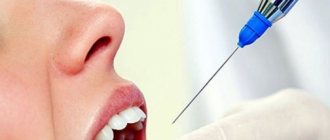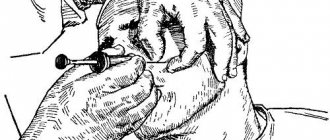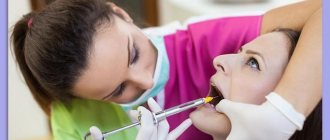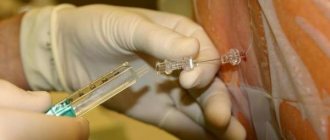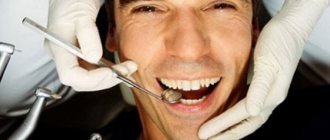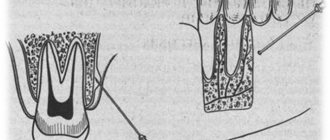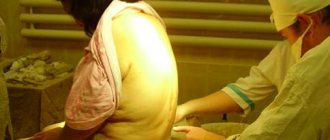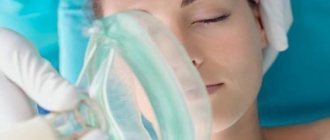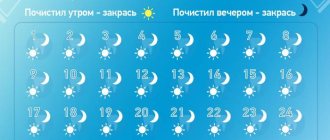Pharmacological properties: When administered by injection near sensory nerve branches, articaine blocks the reversal of painful nerve sensations.
Adrenaline added to the solution slows down the passage of articaine into the general circulation and thus ensures that the active tissue concentration is maintained.
Anesthesia occurs quickly (in 1-3 minutes). The anesthesia is deep and its effect lasts 60-75 minutes.
Quantitative and qualitative composition for one 1.7 ml carpule:
- Articaine hydrochloride 68,000 mg
- Epinephrine tartrate: 0.030 mg epinephrine bitartrate,
Amount corresponding to Adrenaline base:
- Epinephrine base 0.017 mg
- Sodium chloride 2.720 mg
- Sodium disulfite 0.850 mg
- Edetate sodium 0.425 mg
- Sodium hydroxide solution pH 5.3±0.2
- Water for injection solutions 1,700 ml
Classic interventions:
- simple extractions, without complications;
- multiple extractions;
- extraction of unerupted teeth, trepanation;
- resection of the root apex, cyst removal, alveolectomy;
- cavity preparation, biopulpectomy;
- Maxillofacial Surgery. Surgical interventions at the level of the jawbone when they require local anemia or prolonged anesthesia. Interventions at the level of the gum mucosa.
The duration of Septanest anesthesia, during which the intervention can be performed, is 30-45 minutes.
This drug, which does not contain a preservative such as parahydroxybenzoate, can be administered to patients susceptible to allergic reactions to parahydroxybenzoates or chemically related substances.
Contraindications
This drug should not be used in the following cases : children under 4 years of age . Serious cardiovascular disease (such as recent myocardial infarction), heart rhythm disturbances.
Revealed allergy to local anesthetic drugs. Patients undergoing treatment with MAO inhibitors or cyclic antidepressants.
Cardiovascular diseases: arrhythmia (heart rhythm disturbance), heart pathology, coronary heart disease, hypertension, coronary insufficiency. Patients suffering from hyperthyroidism, tremors of the limbs, nervousness, sweat, gastrointestinal disorders, weight loss while maintaining appetite, excitability, increased feelings of fear, fixed gaze, tachycardia, heart rhythm disturbances.
Attention athletes! The drug contains an active substance that may cause a positive reaction during anti-doping control.
Dosage - instructions Septanest 1/100000
Adults
For most current interventions, infiltration of 1.7 ml of SEPTANEST WITH ADRENALINE 1/100000 is sufficient. In all cases, the injection must be carried out slowly (1 ml/min.) - for infiltration at the level of the interdental septum, the amount of the drug from 0.3 ml to 0.5 ml is sufficient. Do not exceed the equivalent of 7 mg of articaine hydrochloride per 1 kg of body weight, which corresponds to six standard 1.7 ml carpules for a patient who weighs 60 kg. The duration of anesthesia during which the intervention can be performed is 30-45 minutes.
Children
Do not use in children under 4 years of age. The amount of injected solution depends on the age of the child and the degree of complexity of the intervention. Do not exceed the equivalent of 7 mg of articaine hydrochloride per 1 kg of weight.
Release form and composition
The solution is available in 1.7 ml injection cartridges - they look similar to standard syringes, only the needles in them are many times thinner. This feature allows the injection to be performed with minimal discomfort for the patient. The drug is presented in two concentrations of the active substance: 1:100,000 and 1:200,000. The price, which varies from 1,500 to 2,000 rubles, also depends on this indicator.
The drug contains articaine and epinephrine
As mentioned above, Septanest contains articaine and epinephrine, as well as auxiliary components such as sodium hydrochloride, sodium bicarbonate and water. For comparison: articaine is 2 times more effective than lidocaine, and novocaine is 6 times more effective1.
Thanks to this composition, Septanest not only blocks pain receptors and neuromuscular transmission, but also affects blood supply. Epinephrine reduces the rate of penetration of articaine into the vascular bed, thereby providing a longer lasting analgesic effect. In this case, the drug is quickly excreted by the kidneys.
Classic interventions:
- simple extractions, without complications;
- multiple extractions;
- extraction of unerupted teeth, trepanation;
- resection of the root apex, cyst removal, alveolectomy;
- cavity preparation, biopulpectomy;
- Maxillofacial Surgery. Surgical interventions at the level of the jawbone when they require local anemia or prolonged anesthesia.
Interventions at the level of the gum mucosa.
The duration of anesthesia during which the intervention can be performed is 15-30 minutes.
This drug does not contain a preservative such as parahydroxybenzoate and can be administered to patients susceptible to allergic reactions to parahydroxybenzoates or chemically related substances.
Ubistezin
Ubistezin is a German drug that is produced. It contains the local anesthetic articaine and the hormone epinephrine (adrenaline), which has a vasoconstrictor effect. Vasoconstriction ensures a low degree of penetration of the drug into the blood and maximum effect at the site of use.
The drug has 2 release forms: with an epinephrine concentration of 1:200000 and 1:100000. The analgesic effect occurs within 1-3 minutes after administration. The duration of action is at least 75 minutes.
The drug is used only for anesthesia in dentistry (infiltration and conduction). It should not be administered intravenously or used in areas of inflammation.
Septanest
Septanest is an anesthetic that has been used in medical practice for quite some time. In addition to articaine and epinephrine, it contains auxiliary substances, which often cause complications of anesthesia in dentistry such as allergic reactions of patients. The drug is available in two dosage forms: with an epinephrine content of 1:100,000 and 1:200,000.
The effect of the drug appears after 1-3 minutes. Its duration is at least 45 minutes. It has good tissue tolerance and has a moderate vasoconstrictor effect.
Scandonest
What anesthesia in dentistry is suitable for patients with diabetes, thyroid diseases, an increased tendency to allergic reactions and patients with bronchial asthma? Scandonest is a drug that does not contain vasoconstrictor components or preservatives. Therefore, it is suitable for all patients at risk. For some, it is used with caution (during pregnancy, diseases of the liver, kidneys and cardiovascular system).
The anesthetic is produced on the basis of 3% mepivacaine. It provides fast, long-lasting and strong pain relief. Suitable for all types of local anesthesia.
Ultracaine
Ultracaine
– this is the best anesthesia in dentistry during pregnancy and for many diseases. It is based on articaine and is available in three forms: with a concentration of epinephrine 1:100000, 1:200000 and completely without epinephrine. The drug contains almost no preservatives. Lasts on average 2-3 hours. According to reviews from dentists and patients, ultracaine is the most potent among its analogues.
The cost of a carpule of any of the listed medications is approximately 30-50 rubles.
This article is for informational purposes only, please consult your doctor for details!
Contraindications
This drug should not be used in the following cases: children under 4 years of age . Serious cardiovascular disease (such as recent myocardial infarction), heart rhythm disturbances.
Revealed allergy to local anesthetic drugs. Patients undergoing treatment with MAO inhibitors or tricyclic antidepressants.
Cardiovascular diseases: arrhythmia (heart rhythm disturbance), heart pathology, coronary heart disease, hypertension, coronary insufficiency. Patients suffering from hyperthyroidism: tremors of the limbs, nervousness, sweat, gastrointestinal disorders, weight loss while maintaining appetite, excitability, increased feelings of fear, fixed gaze, tachycardia, heart rhythm disturbances.
Attention athletes! The drug contains an active substance that may cause a positive reaction during anti-doping control.
Dosage - instructions Septanest 1/200000
Adults
For most current interventions, infiltration is sufficient, 1.7 ml of SEPTANEST WITH ADRENALINE 1/200000. In all cases, the injection must be carried out slowly (1 ml/min.) - for infiltration at the level of the interdental septum, the amount of the drug from 0.3 ml to 0.5 ml is sufficient. Do not exceed the equivalent of 7 mg of articaine hydrochloride per 1 kg of body weight, which corresponds to six standard 1.7 ml cartridges for a patient who weighs 60 kg. The duration of anesthesia during which the intervention can be performed is 15-30 minutes.
Children
Do not use in children under 4 years of age. The amount of injected solution depends on the age of the child and the degree of complexity of the intervention. Do not exceed the equivalent of 7 mg of articaine chloride hydrate per 1 kg of weight.
Septanest with Adrenaline
When the first signs of a side or toxic effect (dizziness, restlessness, impaired consciousness) appear, it is necessary to immediately stop the injection and place the patient in a horizontal position. Careful monitoring of hemodynamic parameters (pulse, blood pressure) and airway patency is necessary. Even if the symptoms do not seem severe, you should prepare everything necessary for an intravenous infusion and, at the very least, perform a venipuncture. Depending on the degree of respiratory impairment, oxygen should be given, artificial respiration (mouth-to-nose) and, if necessary, endotracheal intubation with controlled ventilation. The use of centrally acting analeptic drugs is contraindicated. For involuntary muscle twitching or generalized convulsions, intravenous administration of short-acting or ultra-short-acting barbiturates is indicated. Administration should be carried out slowly, under constant monitoring of hemodynamics and respiration. At the same time, intravenous fluid infusion should be administered through a pre-installed cannula. The patient should also be given oxygen.
In case of tachycardia, bradycardia or a marked decrease in blood pressure, the patient should be placed in a horizontal position with legs elevated. In case of severe circulatory disorders and shock, the injection of the drug should be stopped. Provide the patient with a horizontal position with elevated legs, perform oxygen inhalation and intravenous infusion of balanced electrolyte and plasma-substituting solutions, and administer glucocorticoids intravenously (250-1000 mg of methylprednisolone). In case of threatening vascular collapse and increasing bradycardia, administer intravenously 25-100 mcg of adrenaline (0.25-1.0 ml of a solution with a concentration of 100 mcg/ml). The administration is carried out slowly, under the control of pulse and blood pressure. Do not administer more than 100 mcg of adrenaline (1 ml of solution once). When administering additional amounts of adrenaline, it should be added to the infusion solution. The rate of infusion should correlate with heart rate and blood pressure levels.
Severe forms of tachycardia and tachyarrhythmia can be eliminated by the use of antiarrhythmic drugs, however, non-selective beta-blockers should not be used.
In these cases, it is necessary to use oxygen and monitor hemodynamic parameters. If blood pressure increases in patients with arterial hypertension, peripheral vasodilators should be used, if necessary.
